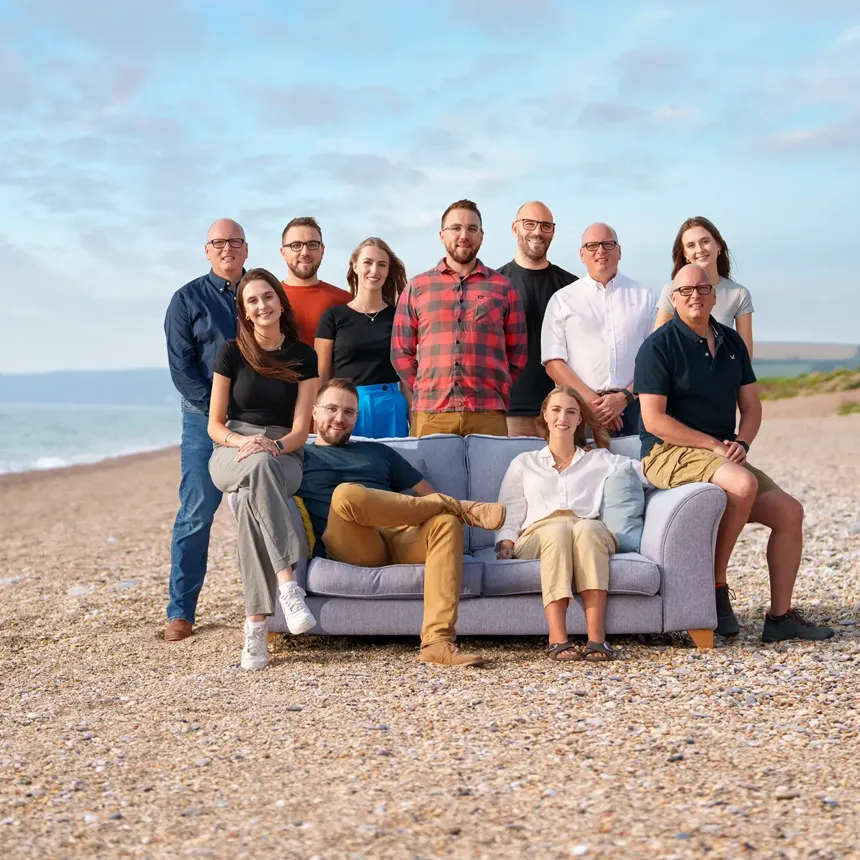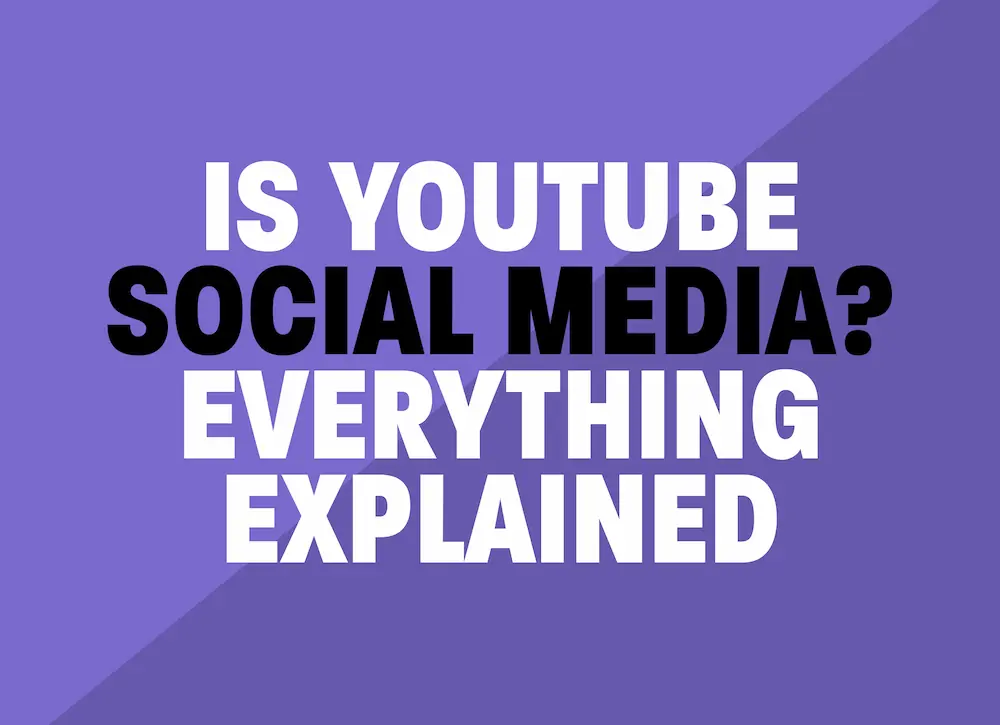When you hear “social media”, platforms like Facebook, Instagram, X, or TikTok might spring to mind. But what about YouTube? Many people wonder if YouTube counts as social media or if it’s “just” a video streaming site. The answer is yes, YouTube is absolutely a social media platform, and a massive one at that. In fact, YouTube has over 2.7 billion monthly users worldwide, making it one of the largest social media platforms in the world.
It’s not only a platform for watching videos, but also an online community where users connect, share, and engage with content.
In this guide, we’ll explain why YouTube qualifies as social media by exploring its community features, engagement mechanisms, personalisation, creator economy, and how it compares with other platforms. We’ll also offer tips on leveraging YouTube’s social features for your brand or business.
What Is Social Media? Does YouTube Fit the Definition of Social Media?
To determine if YouTube is considered social media, it is essential to understand what social media entails.
In simple terms, social media refers to any online platform or service that allows users to share information, content, and interests with others in an interactive way.
Key hallmarks of social media include user-generated content, profiles or accounts for each user, the ability to follow or subscribe to other users’ content, and interactive features like commenting or messaging. Social media is omnipresent nowadays – from social networks like Facebook and LinkedIn to photo-sharing apps like Instagram and community forums like Reddit.
YouTube squarely meets the definition of a social media platform. It enables user-generated content, public sharing of videos, community interaction through comments and subscriptions, and even direct communication between creators and viewers. Essentially, YouTube provides an interactive space where people come together around shared interests, which is exactly what social media is about.
Different Types of Social Media (and Where YouTube Falls)
Not all social media platforms are the same – there are several categories of social media, often defined by their primary function or content format.
For example, some experts group social media into categories like:
- Social networking sites – for connecting with people (e.g. Facebook, LinkedIn).
- Communications-focused platforms – for messaging or status updates (e.g. Twitter, WhatsApp, Facebook).
- Media-sharing networks – for sharing photos or videos (e.g. Instagram, TikTok, YouTube).
- Discussion forums – for community Q&A and topical discussions (e.g. Reddit, Quora).
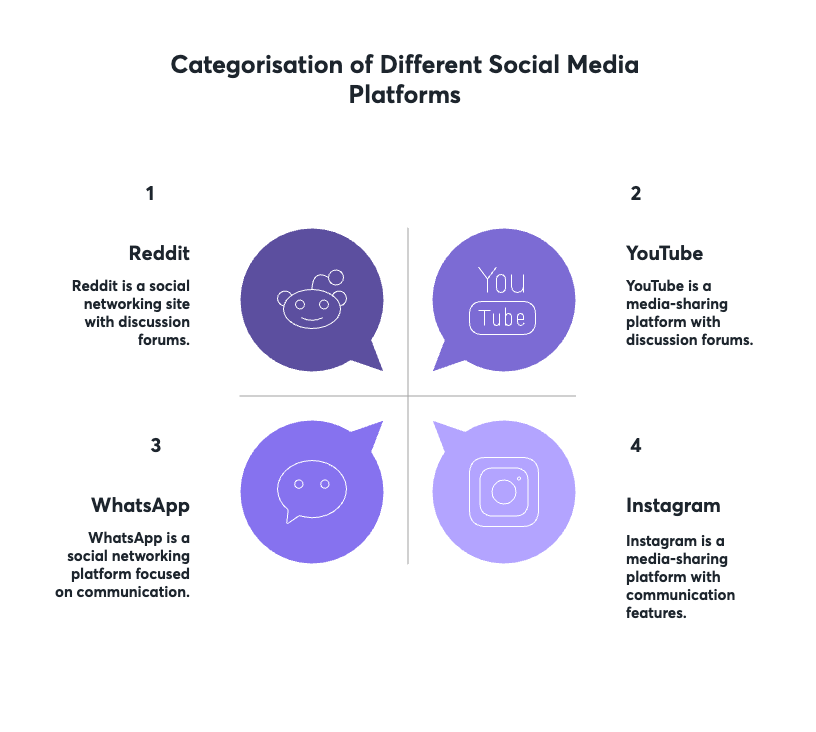
Some sources categorise these into four or five main types, but the concept remains the same.
It’s important to note that many social platforms overlap categories. For instance, Facebook does a bit of everything (networking, messaging, media sharing), and even YouTube has branched into shorter videos (YouTube Shorts) and community posts. However, at its core, YouTube is a social media platform centred on video creation and community engagement, so it falls into the ‘media-sharing’ category.
YouTube’s Evolution into a Social Media Giant
Founded in 2005 by Chad Hurley, Steve Chen, and Jawed Karim, YouTube’s early goal was to make online video sharing easy. The first-ever YouTube video (“Me at the Zoo”) was uploaded in April 2005, marking the start of a new era in online content. What began as a small startup for uploading clips quickly exploded in popularity. By late 2006, Google acquired YouTube, and it was clear that YouTube had tapped into something huge.
Fast forward to today, and YouTube boasts billions of users each month. It’s currently the world’s second most visited website (after Google Search) and the second largest social platform by number of users. YouTube’s user base rivals that of Facebook (around 3.07 billion users worldwide) and far exceeds platforms like Instagram or X. This sheer scale shows that YouTube has grown into far more than a niche video site – it’s a mainstream social network.
Crucially, YouTube’s features and user behaviour evolved to become increasingly social over time. In YouTube’s early days, interaction was limited – viewers could rate videos and leave basic comments. Over the years, YouTube added more social networking features that bring people together, such as user profiles and channels, the ability to subscribe to channels (synonymous to “following” someone on other networks), threaded comment replies and likes, live chats during streams, and the Community tab (where creators can post text and images to engage followers). These features encourage back-and-forth communication between content creators and viewers, transforming YouTube into a community hub rather than a one-way content site.
YouTube now feels very much like a social media community. Viewers don’t just passively watch videos – they like, comment, share, and subscribe, and creators encourage people to do so.
Why YouTube Qualifies as a Social Media Platform
What specific characteristics make YouTube a social media platform? YouTube is considered social media because:
- It’s built on user-generated content, with millions of users uploading videos for everyone to watch.
- It enables interactive engagement – users can like videos, leave comments, share content, and subscribe to channels.
- It creates community and connections, allowing creators and viewers to form communities and interact with each other.
- It provides personalised, algorithm-driven feeds, tailoring content recommendations to each user (just like other social networks).
- It supports a creator economy, where influencers and creators earn money and collaborate, much like on other social platforms.
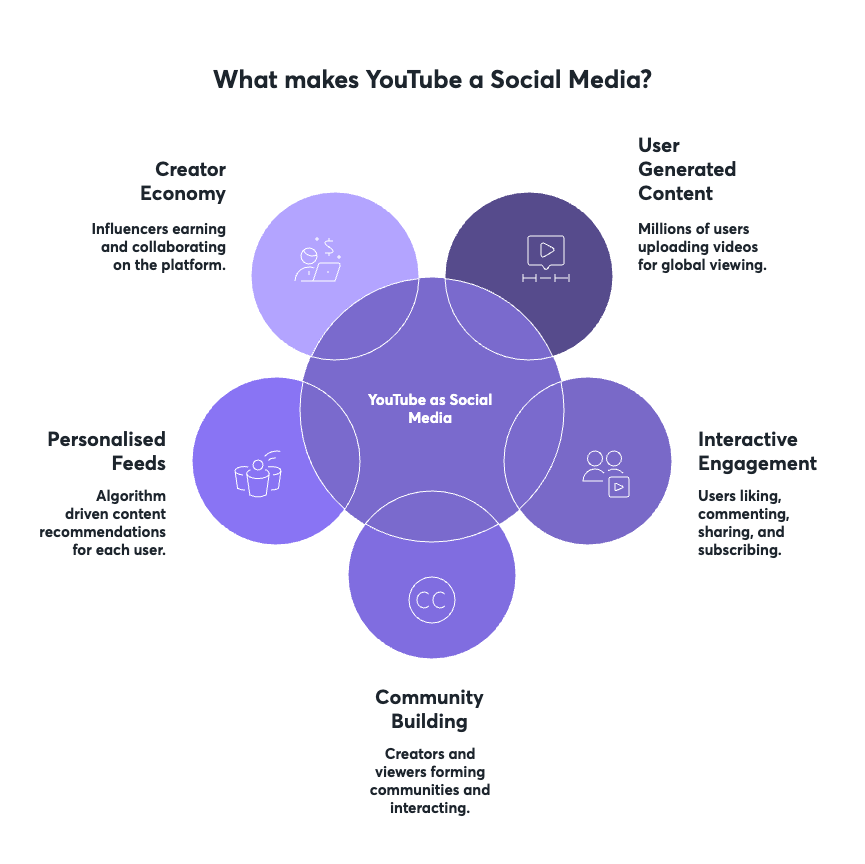
User-Generated Content at the Core
User-generated content (UGC) is at the heart of social media, and YouTube embodies this entirely. Infact, YouTube might be one of the most authentic examples of UGC content. Every video on the platform is created by users, from everyday people to blue-chip brands, making it one of the most authentic platforms online.
Over 500 hours of video is uploaded every minute and YouTube thrives on community-driven content. YouTube doesn’t create the content – its users do. The platform simply provides the tools and reach, empowering creators to engage, connect, and grow communities
Interactive Engagement: Likes, Comments, Shares, and More
YouTube provides a robust suite of engagement mechanisms that facilitate interaction between viewers, creators, and the content itself, including:
Likes/Dislikes: Viewers can give a thumbs-up (like) or thumbs-down on videos. These ratings provide immediate feedback to creators and also influence which videos become more visible or “recommended” on the platform. Videos with more positive engagement tend to be promoted more (such as appearing on YouTube’s front page or recommendation lists), while low-engagement videos are shown less. This voting mechanism is similar to liking posts on Facebook or Instagram, with the added twist that YouTube also allows dislikes to register viewer sentiment.
Comments: Beneath every YouTube video is a comments section where users can discuss the video. Anyone who has scrolled through YouTube comments knows how lively (and sometimes turbulent) the discussion can get! Users often applaud the video, ask questions, or even argue with each other in the comments. This creates a dynamic conversation around the content. For creators, the comment section is an invaluable place to engage with their audience – many YouTubers read and reply to comments.
Shares: YouTube makes it easy to share videos both within the platform and externally. Users can click a share button to post a video’s link to other social networks, or share directly with friends. Within YouTube, there used to be a direct messaging feature (now discontinued), but users still share videos by embedding them in posts or community forums. The ability to quickly spread content to others is a key part of social media virality, and countless YouTube videos have gone viral through user sharing.
Subscriptions: Perhaps the most socially significant feature on YouTube is the subscribe button. When you subscribe to a YouTube channel, you are essentially “following” that content creator. Subscribing means the creator’s new videos will appear in your feed and you may get notifications about their content. It’s a way for users to express support and interest in a creator’s work, and for creators to build an audience community. Popular YouTubers often have millions of subscribers – a clear sign that they have cultivated a large social following on the platform. The subscription model creates a direct channel between creators and fans, enabling ongoing engagement and community-building.
Community Posts and Live Chat: In recent years, YouTube introduced a Community tab for creators with enough subscribers. This feature lets creators publish text posts, polls, images, and updates to engage their audience in between video uploads – much like a Facebook status or a tweet, but to their YouTube subscribers. This is a purely social feature and facilitates conversation and interaction. Additionally, when creators live-stream on YouTube, viewers can interact in real-time via live chat, sending messages and reacting to the stream.
All of these engagement tools mean that YouTube users actively participate rather than passively consume. This interactive environment is directly comparable to any other social network
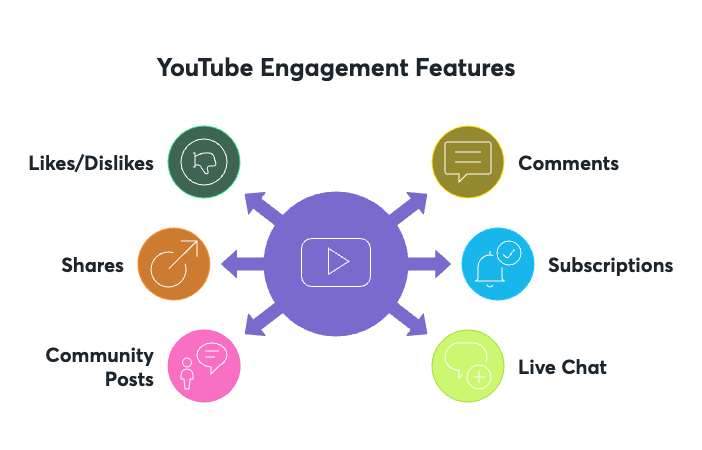
The YouTube Community Effect
At its heart, social media is about community, and YouTube thrives in this space. Unlike platforms built around personal connections, YouTube brings people together through shared interests. Whether it’s vegan cooking or physics, there’s likely a niche of creators and fans who engage, comment, and connect over the content they love.
These interest-based communities naturally form around specific channels. Influencers often treat their channels as hubs, giving fans nicknames, posting updates, hosting Q&As, or encouraging interaction through comments and live chats. Over time, this creates tight-knit groups with their own culture, inside jokes, and loyal followings – much like communities on Instagram or TikTok.
What’s unique is the creator–subscriber relationship. YouTubers often speak directly to their audience, respond to feedback, and incorporate viewer suggestions. In return, fans show loyalty – defending creators online, celebrating milestones, and following their journey across platforms.
Personalised Feeds and Algorithmic Recommendations
One of the defining features of modern social media is personalised content feeds – and YouTube is no exception.
From the moment you start watching, liking, or subscribing, YouTube begins curating a feed just for you. It surfaces new uploads from your favourite creators, recommends similar content, and highlights trending videos in your interest areas.
Watch a few DIY videos, and suddenly you’re connected to a network of creators and like-minded viewers. That’s social connection via content.
Just like other platforms, engagement matters. Videos with more likes, comments, and watch time are more likely to be promoted. YouTube also sends out notifications for new uploads, echoing the update model of other social networks.
The Creator Economy and Influencer Culture
A major sign that YouTube is a social media platform lies in its thriving creator economy and influencer culture. Like Instagram or TikTok, YouTube enables individuals to build large followings and monetise their content through ads, sponsorships, and brand deals.
YouTube helped pioneer this model. Through the YouTube Partner Program, creators can earn ad revenue, transforming content creation into a full-time career. The rise of “YouTubers” proves just how socially driven the platform is. Top influencers like MrBeast reportedly earns over $82 million annually, thanks to YouTube’s viral reach and loyal audiences.
This success depends on audience interaction, and the most successful creators are those who authentically resonate with their community.
YouTube vs. Other Social Media Platforms
Now that we’ve established that YouTube is a social media platform, how does it compare to platforms like Facebook, Instagram, or TikTok?
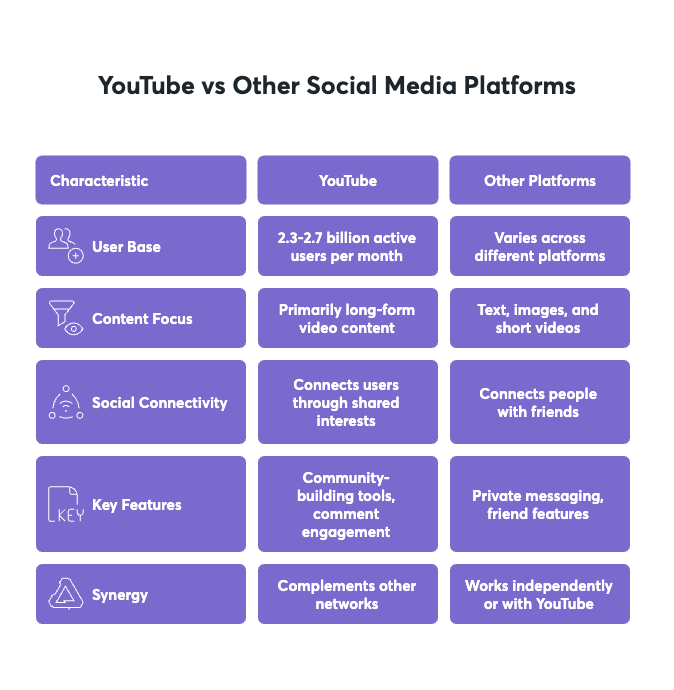
User Base & Popularity
YouTube is one of the most widely used platforms globally, second only to Facebook. Users aged between 25 and 35 account for 21.7% of YouTube’s user base, making it especially dominant among younger users.
Content & Format
While other platforms began with text or images, YouTube has always focused on video, primarily long-form content, though it now also supports Shorts and Community posts. Despite these differences, YouTube mirrors other platforms with features like likes, comments, sharing, and personalised feeds.
Social Connectivity
Unlike Facebook or Snapchat, which focus on connecting people with friends, YouTube connects users through shared interests. Think Reddit-style interaction via video – viewers engage with creators and fellow fans in comments, live chats, and more.
Feature Comparison
YouTube may lack private messaging or “friend” features, but it excels in community-building tools, comment engagement, and discoverability. Its powerful search engine and long content lifespan make it uniquely positioned in the social media mix.
Synergy with Other Platforms
YouTube often complements other networks. Creators post long-form content on YouTube, while engaging fans through Instagram, Twitter, or TikTok. Its influence, reach, and ability to build communities place YouTube firmly alongside the top social platforms – and in some cases, ahead of them.
In short, YouTube might feel different due to its video-first nature, but in functionality and social engagement, it’s as “social media” as they come.
Tips for Engaging and Building Community on YouTube
Success on YouTube isn’t about uploading great videos – it’s about building a loayl, engaged community. Here’s how you can improve upon this.
Know your audience: Create content that answers your viewers’ questions or entertains within your niche. Research trends and pay attention to comments. The more relevant your content, the more people will watch, subscribe, and share.
Optimise Titles & Thumbnails: Your title and thumbnail are your first impression. Make them clear, compelling, and visually striking. Use keywords for discoverability, but focus on making them clickable.
Prompt Interaction: Ask viewers to like, comment, share, or subscribe. Questions, polls, or calls to action in your videos can boost engagement and algorithm visibility.
Engage With Your Viewers: Reply to comments, post updates via the Community tab, and show appreciation. Two-way interaction builds trust, loyalty, and a stronger community vibe.
Collaborate & Stay Consistent: Partnering with other creators expands your reach. Consistent uploads keep your audience engaged and tell the algorithm your channel is active.
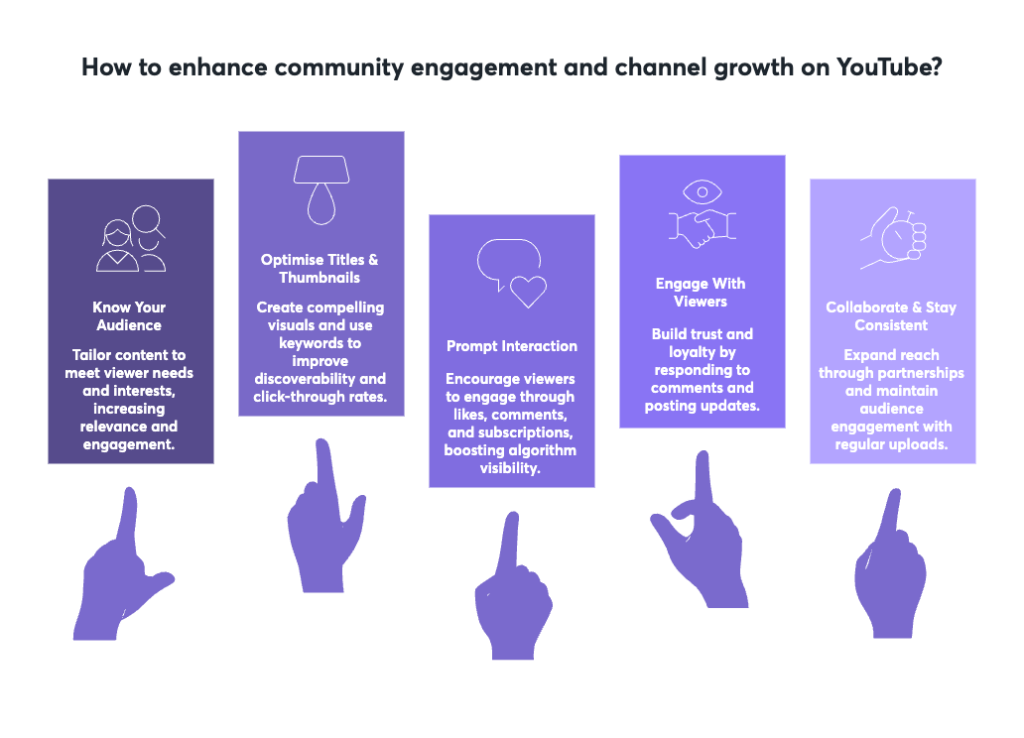
Leverage YouTube Now
YouTube has evolved from a simple video site into a thriving social platform, driven by user content, community interaction, and creator influence. It’s not just about watching videos – it’s about connecting over shared interests.
For individuals and brands alike, YouTube offers powerful tools to build audiences, create engagement, and drive results. To get the most out of it, you need more than great content – you need a smart strategy.
That’s where we come in. We help businesses harness YouTube’s full potential through tailored content, audience-building, video production, and social-led marketing services. Find out how you can turn your channel into a connected, engaged community by getting in touch.


